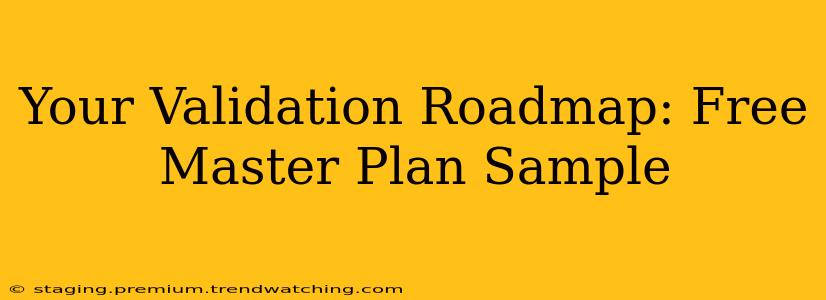Validating your business idea is crucial before investing significant time and resources. A solid validation roadmap helps you systematically test your assumptions and de-risk your venture. This free master plan sample provides a framework you can adapt to your specific needs, guiding you through the process of proving your business's viability. We'll cover key steps and answer common questions, providing you with a clear path towards confident launch.
What is a Validation Roadmap?
A validation roadmap isn't just a list of tasks; it's a strategic plan to systematically test your core business assumptions. It's a structured approach to proving whether there's a genuine market need for your product or service, whether you can reach that market effectively, and whether you can build a sustainable business model around it. This roadmap acts as your guide, preventing you from wasting time and money on ideas that lack market validation.
Key Components of a Validation Roadmap
A successful validation roadmap incorporates these essential elements:
- Clearly Defined Problem: What problem are you solving? This needs to be specific and well-articulated.
- Target Customer Profile: Who is your ideal customer? Go beyond demographics; understand their needs, motivations, and pain points.
- Proposed Solution: How does your product or service address the identified problem?
- Key Assumptions: What are the underlying assumptions about your market, your customers, and your business model? These are the hypotheses you need to test.
- Validation Metrics: How will you measure success? Define clear, quantifiable metrics to track your progress.
- Testing Methodology: What methods will you use to test your assumptions (e.g., surveys, interviews, landing pages, MVP)?
- Timeline & Milestones: Set realistic deadlines for each stage of validation.
- Iteration & Adjustment: Be prepared to adapt your plan based on your findings. Validation is an iterative process.
What are the Different Stages of the Validation Process?
The validation process is rarely linear. However, a common approach involves these phases:
- Problem Validation: Confirm that the problem you're solving is real and significant for your target customer.
- Solution Validation: Ensure your proposed solution effectively addresses the identified problem.
- Market Validation: Determine if there is a sufficient market size and demand for your solution.
- Business Model Validation: Test the viability of your revenue model and pricing strategy.
What are the Most Effective Validation Methods?
Numerous methods can help you validate your business idea. The optimal choice depends on your resources and the stage of validation:
- Customer Interviews: Conduct in-depth interviews to understand customer needs and pain points directly.
- Surveys: Gather quantitative data from a larger audience to assess market interest.
- Landing Pages: Create simple landing pages to gauge interest and collect email addresses.
- Minimum Viable Product (MVP): Develop a basic version of your product to test core features and gather user feedback.
- Competitor Analysis: Analyze your competitors' strengths and weaknesses to identify opportunities and potential challenges.
How Long Does the Validation Process Typically Take?
The duration of the validation process varies significantly depending on the complexity of your business idea and the resources available. It can range from a few weeks for simple ideas to several months or even years for more complex ventures. Don't rush this crucial step; thorough validation is an investment in your long-term success.
What if My Validation Results are Negative?
Negative validation results, while initially disappointing, are valuable learning experiences. They indicate that your initial assumptions were incorrect, allowing you to adjust your strategy or even pivot to a new idea before significant resources are invested. Embrace failure as an opportunity for growth and refinement.
Free Validation Roadmap Template (Sample)
(This section would ideally contain a downloadable template, but as per instructions, I cannot provide a direct download link. The following is a textual representation of what such a template might include):
Project Name: [Your Business Idea]
Problem Statement: [Clearly define the problem you're solving]
Target Customer Profile: [Detailed description of your ideal customer]
Proposed Solution: [Description of your product/service]
Key Assumptions: [List your core assumptions about the market, customers, etc.]
Validation Metrics: [Quantifiable metrics to measure success]
Validation Methods: [List the methods you'll use (interviews, surveys, MVP, etc.)]
Timeline: [Set realistic deadlines for each stage]
Milestones: [Key achievements to track progress]
This sample roadmap provides a starting point for your validation journey. Remember to customize it to fit your specific needs and continuously iterate based on your findings. Thorough validation significantly increases your chances of building a successful and sustainable business.

